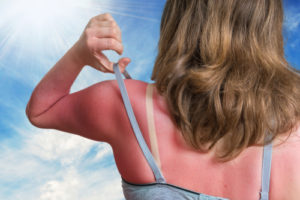
Preventing Sunburn
A common mistake many people make is thinking that they don’t need to protect their skin when going outside for a few minutes or driving in their car. The truth is, you can get a sunburn anytime, anywhere – even sitting in traffic or at your desk at work. So how can you keep your skin safe? Sunscreen! The FDA recommends you wear a minimum of SPF 15 year-round on all exposed skin – but the American Academy of Dermatology recommends an SPF30 UVA/UVB sunscreen year-round.
Don’t make the all-too-common mistake of not following the instructions on the bottle. If you’ve been outside sweating or swimming, be sure to reapply your sunscreen frequently – and you still need to reapply it even if you’re not sweating or swimming. Even sitting in traffic with the windows up and the AC blasting will break down the protective elements of your sunscreen.
In addition to sunscreen, when possible, wear protective clothing like wide-brimmed hats, sunglasses and long-sleeved shirts or pants. And don’t forget to apply sunscreen to lips, ears and exposed scalp. If possible, avoid the sun between 10 a.m. and 3 p.m., the time of day when the sun’s UV rays are at their most potent and dangerous.
Treating Sunburn
So, you’ve already got a sunburn. Now what? Here’s what to do to cool the burn and heal your skin.
• Take a cool bath. This will ease some of the pain from the burn and cool down the skin.
• Apply a lotion or aloe vera gel to wet skin to lock in moisture. You may want to store a bottle in the fridge during the summer months just in case of accidental burns.
• Take an NSAID like aspirin or ibuprofen to help reduce pain and swelling.
• If skin blisters, leave the blisters alone and do not try to peel, pick at or pop them.
• Seek immediate medical attention if your sunburn causes fever, chills or headache.
• Stay out of the sun until your burn has healed.
Correcting Sun Damage
Whether you’ve been a lifelong tanner or just had a few severe sunburns in your lifetime, it’s not uncommon for sun damage to appear on your skin later in life. The good news is there are many treatments you can get right in Dr. Chau’s office to correct some of this damage. Here are some safe, effective options:
Equinox fractional CO2 laser: Sometimes burns can be good for you – as is the case with the Equinox laser. This ablative laser burns off the first few layers of skin, helping to reduce wrinkles, acne scars, sun spots and fine lines and even remove precancerous and benign lesions.
ZO Skin Health products: The ZO Skin Health line is sold through medical professionals and contains higher concentrations of active ingredients than regular department store skin care products. Developed by famed dermatologist Dr. Zein Obagi, the line addresses a wide variety of skin care problems, including dark spots and wrinkles from sun damage. ZO Skin Health also carries a sunblock – so you never need to worry about being caught without protection again.
To learn more about the ZO Skin Health line or to schedule a consultation for the Equinox fractional CO2 laser, please give Dr. Chau’s office a call at 888-966-9471.
